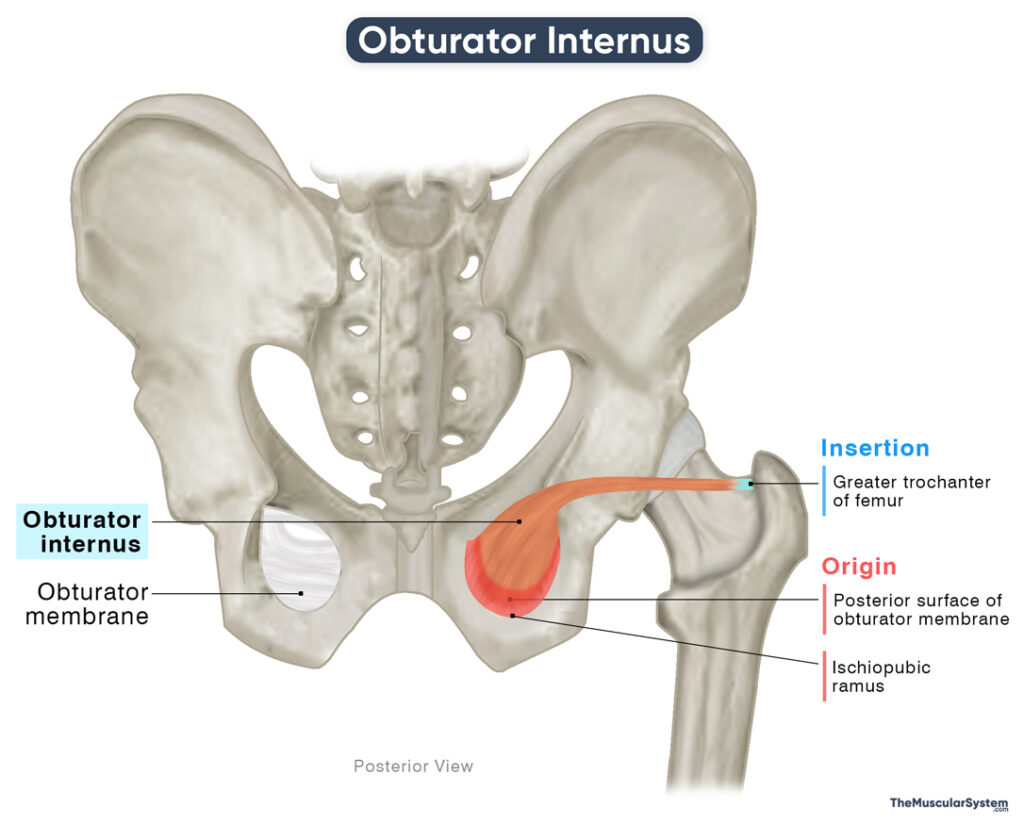Obturator Internus
Last updated:
17/07/2025Della Barnes, an MS Anatomy graduate, blends medical research with accessible writing, simplifying complex anatomy for a better understanding and appreciation of human anatomy.
What is the Obturator Internus
The obturator internus, also known as the internal obturator, is a small, paired, convergent muscle belonging to the buttock or gluteal region. It is one of the lateral rotators of the thigh, along with the piriformis, obturator externus, quadratus femoris, and the gemellus muscles. The same muscles, except the obturator externus, also form the deep muscle layer of the gluteal region.
Despite its small size, the muscle plays an important role in maintaining the flexibility of the hip and thigh regions.
Anatomy
Although classified as a lower limb muscle, the obturator internus lies partly within the pelvic region and partly in the gluteal region.
Location and Attachments
| Origin | The ischiopubic ramus and the posterior surface of the obturator membrane |
| Insertion | Trochanteric fossa of the femur |
Origin
The muscle originates from the pelvic (inner) surface of the hip bone, within the true pelvis. Its fibers arise from the bony margins of the obturator foramen, primarily the ischiopubic ramus, as well as the ischial and inferior pubic rami. The posterior surface of the obturator membrane serves as the second point of origin. The origin also extends to the inner front surface of the pelvic bones, below the pelvic brim, and up to the margin of the greater sciatic foramen.
Insertion
From its broad origin, the muscle fibers of the obturator internus converge laterally into a few strips of narrow tendons. Near the ischial spine, the tendon makes a sharp backward turn around the lesser sciatic notch and passes through the lesser sciatic foramen. At this point, a small bursa called the bursa of obturator internus lies between the tendon and the ischium to allow smooth movement of the muscle over the bone.
After emerging from the foramen, the tendon continues laterally, crosses the posterior aspect of the hip joint, and inserts onto the medial surface of the greater trochanter of the femur, specifically into the trochanteric fossa.
Relations With Surrounding Muscles and Structures
Within the true pelvis, the obturator fascia lies medial to the obturator internus muscle, covering its medial surface. The obturator fascia is an important pelvic structure, providing attachment for the levator ani muscles. In the gluteal region, the muscle lies deep to the gluteus maximus, which covers its posterior aspect. The sciatic nerve courses superficial to the muscle as it passes through the greater sciatic foramen and travels toward the thigh and leg.
In the pelvis, the urinary bladder lies anterior and medial to the obturator internus, while the ischioanal fossa lies inferior and medial to it.
Within the gluteal region, the tendon of the muscle passes between the two gemellus muscles, with the superior gemellus lying above the tendon, and the inferior gemellus lying below it. The tendons of the gemellus muscles often blend with those of the obturator internus, and together they form the triceps coxae.
Function
| Action | Rotating the thigh laterally, helping abduct it when the hip is flexed (minor), and stabilizing the hip |
Rotating the thigh externally: With its attachment to the greater trochanter of the femur, this muscle, along with the two gemelli, contracts to rotate the extended thigh outward (lateral rotation). An example of this is turning your toes outward while standing or crossing one ankle over the opposite knee while sitting.
Abducting the thigh: As the obturator internus tendon bends around the lesser sciatic notch, its line of pull allows it to contribute to abduction of the thigh when it is already flexed, as when you swing your knee outward to get out of a car. However, this is a minor action.
Stabilizing the hip joint: As one of the short muscles of the hip region, it plays an important role in stabilizing the femoral head within the acetabulum and supporting the stability of the hip joint and overall posture.
Antagonists
The antagonists of the obturator internus include the medial rotators of the thigh, such as the gluteus medius and minimus, and the tensor fasciae latae, which oppose its lateral rotation.
When the hip is flexed and the obturator internus assists in abduction of the thigh, its action is opposed by the hip adductor muscles, including adductor longus, brevis, magnus, gracilis, and pectineus. However, these are not considered its primary antagonists.
Innervation
| Nerve | Nerve to obturator internus (L5-S2) |
The obturator internus muscle is innervated by the nerve to obturator internus, also called the obturator internus nerve. This deep gluteal nerve arises from the sacral plexus and is formed by fibers from the 5th lumbar and the 1st and 2nd sacral nerve roots (L5, S1, and S2).
Blood Supply
| Artery | Inferior gluteal artery |
The primary blood supply to the muscle comes from the inferior gluteal artery. Additional vascular contributions come from the muscular branches of the obturator artery, the gemellar and inferior rectal branches of the internal pudendal artery, and the superior gluteal artery. All of these arteries arise from the internal iliac artery.
References
- Obturator Internus: TeachMeanatomy.info
- Anatomy, Abdomen and Pelvis, Obturator Muscles: NCBI.NLM.NIH.gov
- Obturator Internus Muscle (Anatomy): PrimaryCareNotebook.com
- Obturator Internus Muscle: Kenhub.com
- Obturator Internus: Elsevier.com
- Obturator Internus Muscle: Radiopaedia.org
Della Barnes, an MS Anatomy graduate, blends medical research with accessible writing, simplifying complex anatomy for a better understanding and appreciation of human anatomy.
- Latest Posts by Della Barnes, MS Anatomy
-
Extensor Digitorum Brevis
- -
Extensor Hallucis Brevis
- -
Posterior Compartment of the Leg
- All Posts






